Hormone-Refractory Prostate Cancer: Choosing the Appropriate Treatment Option
Hormone-refractory prostate cancer (HRCaP) is both heterogeneous and lethal. Multiple treatment options exist, including secondary hormonal manipulations, chemotherapy, experimental options, and best supportive care. Choosing the appropriate therapy for an individual patient depends on several important clinical factors such as the presence or absence of symptomatic metastatic disease, age and comorbidities, and prostate-specific antigen velocity. While only docetaxel (Taxotere)-based chemotherapy has been proven to improve survival in this setting, a wide range of therapies may be effective for any individual. Palliative maneuvers, such as external-beam radiation, bisphosphonate therapy, radiopharmaceuticals, and pain management are critical for appropriate patient management. Several promising novel therapies are in late-stage testing and will hopefully provide more treatment options for these patients.
Hormone-refractory prostate cancer (HRCaP) is both heterogeneous and lethal. Multiple treatment options exist, including secondary hormonal manipulations, chemotherapy, experimental options, and best supportive care. Choosing the appropriate therapy for an individual patient depends on several important clinical factors such as the presence or absence of symptomatic metastatic disease, age and comorbidities, and prostate-specific antigen velocity. While only docetaxel (Taxotere)-based chemotherapy has been proven to improve survival in this setting, a wide range of therapies may be effective for any individual. Palliative maneuvers, such as external-beam radiation, bisphosphonate therapy, radiopharmaceuticals, and pain management are critical for appropriate patient management. Several promising novel therapies are in late-stage testing and will hopefully provide more treatment options for these patients.
Recurrent prostate cancer (CaP) is a disease of years, even decades. In one study, the median time between prostate-specific antigen (PSA) recurrence after radical prostatectomy (RP) and death was 13 years.[1] Given this prolonged natural history, CaP can be best understood using a disease state model. This model divides the natural history of CaP into four clinically valuable disease states-(1) clinically localized disease, (2) rising PSA, (3) clinical metastases, noncastrate, and (4) clinical metastases, castration-resistant.[2] This article will review the management of castration-resistant, or hormone-resistant, CaP (HRCaP).
A Biologically and Clinically Heterogeneous Disease
HRCaP is also called androgen-independent CaP but better conceptually thought of as castration-resistant CaP. All refer to the same clinical phenomenon, which is the growth of CaP despite low plasma levels of total testosterone, typically to < 50 ng/dL. Such a reduction in serum testosterone is achieved with either a leutinizing hormone-releasing hormone (LHRH) agonist (eg, leuprolide acetate or goserelin acetate [Zoladex]) or surgical castration. Cancer growth is usually documented radiologically, or with serial increases in serum PSA levels (at least two rises, at least 1 week apart, using the same assay).[3] Checking serum testosterone levels is recommended as an initial evaluation in such patients because at least 5% do not have castrate levels of the androgen, in which case surgical castration should be considered.[4]
One problem with the use of the terms "hormone-refractory" or "androgen-independent" is that many of these tumors are still responsive to therapies that alter the androgen milieu. For example, the addition of exogenous testosterone to patients with HRCaP may shorten their survival.[5] Moreover, therapies that either interfere with the binding of androgens to the androgen receptor or decrease the adrenal androgen contribution produce 20% to 40% response rates in the castrate state. Thus, the term HRCaP denotes a disease state that is not truly refractory. Rather, "hormone -refractoriness" describes a spectrum of sensitivities to further androgen-manipulation.
The clinical observation that responses to secondary hormonal manipulation are heterogeneous is reflected in the underlying biology of HRCaP. While not well elucidated, it seems clear that there are several possible pathways to the acquisition of the castration-resistant phenotype (Table 1).[6] This biologic heterogeneity is further exemplified by the results of rapid autopsy studies. One study demonstrated significant variation in the expression of proteins felt to be important in HRCaP not only between patients but also between metastases to different organs in the same patient.[7] Given this inter- and intrapatient biologic heterogeneity, it is not surprising that response rates to various targeted agents in this disease state are low. The critical question is identifying which HRCaP tumors will respond to any particular therapy.
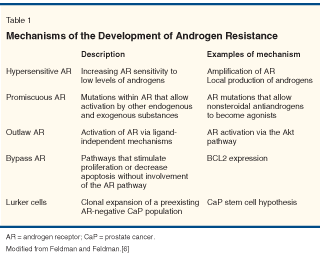
Clinically, HRCaP is also heterogeneous. With the use of serum PSA tests, the diagnosis of HRCaP can be made long before metastases are diagnosed. Many of these patients are initially asymptomatic and may have many years before any clinical sequellae appear. In a study of 201 patients with HRCaP but without bone metastases, only 33% of men developed bone metastases (as noted by bone scan) at 2 years.[8] Predictors of the development of bone metastases included baseline PSA level and PSA velocity. Thus, patients with HRCaP without metastatic disease can remain asymptomatic for years.
On the other hand, the median survival for patients with metastatic HRCaP is 18 to 22 months.[9,10] The most comprehensive evaluation of prognostic markers for survival in this disease setting was performed by Halabi and colleagues.[11] A dataset of 1,101 men from six different Cancer and Leukemia Group B (CALGB) studies was evaluated. All of these men had HRCaP with metastases. Statistically significant prognostic factors of overall survival in a multivariate analysis included performance status, Gleason sum, serum lactate dehydrogenase (LDH), PSA, hemoglobin, and alkaline phosphatase, and the presence of visceral disease. These prognostic factors have been incorporated into a nomogram.
Treatment Options
There are three basic categories of treatment options in HRCaP: supportive care, secondary hormonal manipulations, and chemotherapy. In most centers, clinical trials can be added to this list. Many of these treatment options can be effective in the right patient population, yet the only treatment proven to extend survival in HRCaP is docetaxel chemotherapy.[9,10] Moreover, as described below, the phase III studies of docetaxel were performed in a subset of HRCaP-men with mostly symptomatic, metastatic HRCaP.
Therefore, for an individual patient, we select therapy based on multiple factors, including the patient's age, performance status and comorbidities, PSA velocity, the presence or absence of metastatic disease, the presence or absence of symptomatic disease, and the prognostic factors from the CALGB nomogram. For men with multiple comorbidities and a poor performance status but without evidence of metastases, watchful waiting may be the best option. On the other hand, those with symptomatic, metastatic disease who are otherwise in good health are best managed with chemotherapy. For the vast group of patients with HRCaP and a minimal metastatic burden without symptoms, secondary hormonal manipulation or experimental options are reasonable as initial therapy.
Even with a watchful waiting approach, primary androgen deprivation should be maintained. Clinical trials in HRCaP in which testosterone was added to chemotherapy had inferior outcomes to chemotherapy alone, arguing that even in HRCaP, at least a subset of tumor cells remain sensitive to androgens.[5] Interestingly, though, the return of testosterone is highly variable with the discontinuation of androgen-deprivation therapy. In older men who have been on androgen-deprivation therapy for long periods of time, the return to noncastrate serum testosterone levels after the discontinuation of androgen-deprivation therapy may take a long time if it returns at all.[12] Thus, in patients not on clinical trials, it is not unreasonable to discontinue LHRH use and closely monitor testosterone levels.
Secondary Hormonal Manipulations
The array of potential secondary hormonal maneuvers for HRCaP is vast and can be broken down into several subsets-antiandrogen use and withdrawal, estrogens and progestins, P450 enzyme inhibitors, and corticosteroids.[13] Very few well-powered randomized trials have been reported comparing any of these therapies, and none of these therapies has been shown to improve survival. Typically, they are evaluated in single-arm phase II trials using PSA response rates (the percentage of patients who experience a drop in their PSA by ≥ 50% during treatment) as an efficacy endpoint. The surrogacy of PSA response rates for a clinically meaningful endpoint such as survival with the use of secondary hormonal interventions in HRCaP is not established; yet, because of its widespread (although still controversial use) as a surrogate in metastatic HRCaP being treated with chemotherapy, it is often the primary outcome measure in studies of secondary hormonal manipulations and has been recommended by the PSA Working Group, with standards of measuring and reporting.[3,14]
• Antiandrogens-The addition of a nonsteroidal antiandrogen is often the first treatment once a diagnosis of HRCaP has been established. Three nonsteroidal antiandrogens are approved for use in the United States-flutamide (Eulexin), bicalutamide (Casodex), and nilutamide (Nilandron). They each bind to the androgen receptor and block its interaction with testosterone and dihyroxytestosterone. These agents share a common toxicity profile, which includes gynecomastia, gynecodynia (both far more often seen in men whose serum testosterone levels are normal), reversible transaminitis, nausea and diarrhea (more commonly seen with flutamide), and, rarely, interstitial lung disease. Delayed adaptation to darkness is reported with nilutamide.
All three nonsteroidal antiandrogens have efficacy in HRCaP. In a series of 209 men treated with flutamide (250 mg three times a day) after progression on primary androgen-deprivation therapy, 35% of the men responded to treatment.[15] All of these men had metastatic disease. Response rates are higher in men without established metastasis.[16] A randomized trial of flutamide vs prednisone in symptomatic HRCaP did not demonstrate a difference in response rate, time to progression, or overall survival.[17]
Similar efficacy results have been seen with high-dose bicalutamide (150 mg per day), with improved efficacy in men who had already been treated with flutamide, due perhaps to the fact that mutations in the androgen receptor that convert flutamide to an agonist do not have a similar effect with bicalutamide.[18] Nilutamide has efficacy as both a secondary hormonal therapy and after failure of either bicalutamide or flutamide.[19,20]
For men already on an antiandrogen at the time of the diagnosis of HRCaP, the first therapeutic manipulation is to stop the antiandrogen (while continuing the primary mode of androgen deprivation). Described first in the early 1990s with flutamide, antiandrogen withdrawal (AAW) responses have been seen after discontinuation of every nonsteroidal antiandrogen.[21] In the largest prospectively collected study to evaluate AAW, 11% of men with metastatic HRCaP had a PSA response, while 2% had an objective response.[22] Patients who had a PSA response had 5.9 months on average until PSA progression. The response rate to AAW in this study may have been lower than previous reports because many of the patients who underwent AAW were on flutamide as a secondary hormonal therapy rather than as part of initial therapy.
As the half-lives of nilutamide (1 week) and bicalutamide (2 days) are significantly longer than that of flutamide (5 hours), it can take up to 4 to 6 weeks for an AAW response to manifest with these agents. The mechanism of the AAW response is unknown. It was initially felt to be due to acquired mutations in the androgen receptor that result in its activation when bound to an antiandrogen, but other studies have found that these mutations do not explain most AAW responses.[23]
• Estrogens and Progestins-Estrogens and progestins have long been known to have an inhibitory effect on CaP, although through unclear mechanisms. Diethylstilbestrol (DES, a synthetic estrogen) has been studied extensively in hormone-sensitive CaP and found to be efficacious (in part, by lowering serum testosterone to castrate levels) but associated with lethal cardiovascular events. In the HRCaP setting, a small (58-patient) randomized trial compared 1 mg/d of DES to bicalutamide and found a similar PSA response rate (23 vs 31%, respectively), but again, revealed cardiovascular toxicity in the DES group.[24]
Other estrogen preparations have been evaluated as well in HRCaP (see Table 2). In these studies, a low dose of coumadin is often used to prevent thromboembolic events. An alternative delivery system, the estrogen patch, has also been used to prevent these events by avoiding the thrombophilic first-pass effect on the liver.[25] Other toxicities of estrogenic treatment include gynecomastia and mastodynia, which can be prevented with breast irradiation.
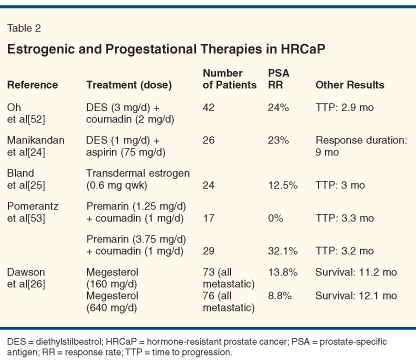
Progestins evaluated in HRCaP include megestrol acetate (a synthetic progestin), medroxyprogesterone acetate, and cyproterone acetate, a steroidal antiandrogen with progestational properties. Cyproterone acetate is associated with liver toxicities and is not approved for use in the United States. PSA response rates to megesterol acetate are reported as 9% to 14%, with no difference between low (160 mg/d) and high (640 mg/d) doses.[26] Moreover, 7% of subjects experience a flare of their pain within a week of beginning megesterol, although the pain may improve despite the continuation of therapy.
• P450 Enzyme Inhibitors-The adrenal glands produce up to 30% of androgenic steroids. These adrenal androgens are not affected by primary androgen deprivation therapy and may contribute to progression to the hormone-refractory state. Thus, several different approaches have been evaluated to eliminate adrenal androgens (Table 3), including adrenalectomy and treatment with ketoconazole and aminoglutethimide. Ketoconazole, an imidazole antifungal that is also a potent CYP3A4 inhibitor, is the most studied. Treatment with ketoconazole results in marked decreases in circulating adrenal androgens but can also result in adrenal insufficiency. Therefore, ketoconazole treatment (particularly in high doses) is usually accompanied by steroid supplementation (which also has activity in HRCaP).
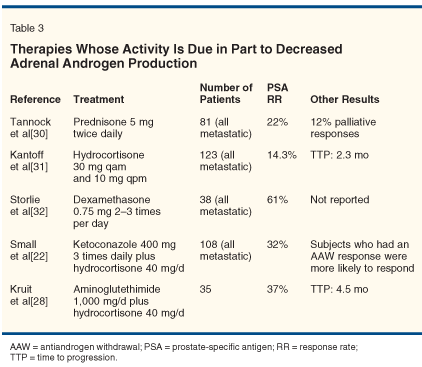
Multiple trials have evaluated ketoconazole treatment in HRCaP, at different dose levels (200 or 400 mg three times daily). Reported PSA response rates range from 30% to 60%, with a response duration of 3 to 8 months. In the largest randomized experience with ketoconazole, 260 men were randomized to AAW alone or AAW plus ketoconzole and hydrocortisone.[22] The PSA response rate to ketoconazole with AAW 27%, with an objective response rate of 20% and a median time to progression of 8.6 months. Of the men initially treated with AAW alone, 108 went on to receive deferred ketoconzaole; 32% of these men had a PSA response, and 7% had an objective response. Of note, no survival difference was seen between these two arms. Interestingly, adrenal androgen levels, which fell in response to ketoconazole treatment, rose at the time of disease progression, suggesting a possible mechanism of resistance.
Ketoconazole toxicity includes adrenal insufficiency, nausea, anorexia, vomiting, rash, and a reversible transaminitis. Ketoconazole should be taken on an empty stomach without antacids, as a low gastric pH is important for absorption.
Other adrenal steroid synthesis inhibitors with activity in HRCaP include aminoglutethimide (which inhibits the conversion of cholesterol to pregnenolone), although it is rarely used.[27,28] The novel 17-alpha hydroxylase inhibitor abiraterone acetate is in clinical trials, with preliminary data indicating a high PSA response rate (67%) with minimal toxicity.[27,29]
• Steroids-Steroids have some utility in HRCaP, both due to pain palliation and potentially due to a decrease in adrenal androgen production via adrenocorticotropic hormone suppression. Several studies have considered pain relief and palliation from prednisone use (5 to 10 mg/d), and found subjective improvement in 20% to 40% of men. PSA responses are seen in 16% to 50% of men treated with prednisone, hydrocortisone, or dexamethasone.[30-32]
Chemotherapy
Only recently has it been recognized that chemotherapy has a role in the treatment of HRCaP. Agents such as mitoxantrone, estramustine (Emcyt), and the vinca alkaloids provide palliative improvement but not a survival benefit. In 2004, however, two multicenter, phase III trials were published demonstrating a survival benefit to the use of docetaxel-based chemotherapy.
The first trial, TAX 327, randomized 1,006 men with metastatic HRCaP to docetaxel at 75 mg/m2 every 3 weeks, docetaxel at 30 mg/ m2 weekly, or mitoxantrone at 12 mg/m2 every 3 weeks. All subjects received prednisone, 5 mg twice daily. This trial demonstrated a statistically significant survival benefit to the docetaxel arms (median survival of 18.9 months for the every-3-week docetaxel arm, vs 17.4 and 16.5 months for weekly docetaxel and mitoxantrone, respectively). The predominant side effect was neutropenia, seen in 32% of men on the every-3-week docetaxel arm. Febrile neutropenia was rare (3%).[9]
The second phase III trial of a docetaxel combination was performed by the Southwestern Oncology Group (SWOG) and compared docetaxel plus estramustine to mitoxantrone plus prednisone.[10] This trial also demonstrated a statistically significant survival benefit to the docetaxel-containing arm (17.5 vs 15.6 months). The docetaxel-plus-estramustine arm was associated with significant toxicity, including higher rates of cardiovascular events (15% vs 7%) and vomiting (20% vs 5%). There were eight treatment-related deaths with docetaxel and estramustine, and four with mitoxantrone.
With these results, docetaxel was approved for use with prednisone in metastatic HRCaP in the United States. Given the toxicity with the estramustine combinations and the higher point estimate for survival in the every-3-week arm, every-3-week docetaxel (without estramustine) has been widely adopted as the first-line chemotherapy regimen in this disease.
Multiple other chemotherapeutic agents have been evaluated in metastatic HRCaP, although none to date are associated with a survival benefit (see Table 4). Randomized trials have been rare, and patient populations may differ by whether they had already received docetaxel. It is expected that responses rates in the post-docetaxel setting will be less impressive.[33,34] While some of the response and survival data from the multiagent first-line studies is promising, phase III trials are needed before these regimens can be incorporated into standard practice.
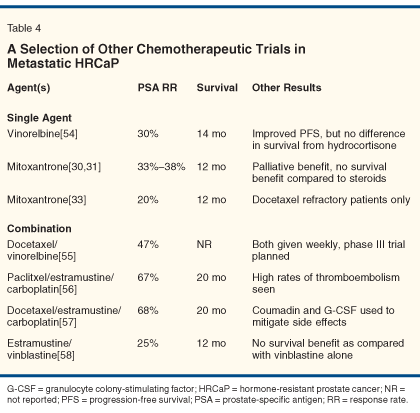
Bone-Directed Treatments
Bone is the most common site of metastases for HRCaP patients and the most common site of CaP-related complication. These complications include pain, pathologic fracture, cord compression, and hypercalcemia. Three bone-directed therapies are available for metastatic HRCaP to help ameliorate these complications-external-beam radiation therapy, bisphosphonates, and bone-targeted radioisotopes.
• Radiation Therapy-External-beam radiation is very effective at palliating painful metastatic sites. Care should be taken to ensure that the lesion being irradiated corresponds with the symptomatic area. Retreatment is sometimes needed, which can cause marrow toxicity and interfere with planned chemotherapy.
• Bisphosphonates-Several bisphosphonates have been evaluated in the setting of metastatic HRCaP. The Zometa 039 study randomized 643 men with metastatic HRCaP to intravenous zoledronic acid (Zometa) or placebo.[35] At 15 months, a statistically significant difference was seen between the zoledronic acid group and the placebo group in terms of the incidence of skeletal-related events (33% vs 44%) and median time to first skeletal-related event (546 vs 464 days). No statistically significant difference in survival was seen.
Other trials evaluating two other bisphosphonates (pamidronate [Aredia] and clodronate [Bonefos]) in this patient population did not show differences in skeletal-related events.[36,37] This difference may be due to the improved potency of zoledronic acid as compared with these other bisphosphonates in terms of inhibiting osteoclast-mediated bone resorption. Thus, for men with HRCaP metastatic to the bone, zoledronic acid (4 mg intravenously every month) is indicated to decrease skeletal-related events.
Important side effects of zoledronic acid include renal insufficiency and osteonecrosis of the jaw. Novel approaches for decreasing skeletal-related events in HRCaP include the use of denosumab, an antibody directed against the receptor activator of nuclear factor kappaB ligand (RANKL).[38]
• Radioisotopes-Bone-targeted radioisotopes are also used in men with painful metastatic disease from HRCaP. Three radiopharmaceuticals (Table 5) are currently available in the United States-phosphorus-32 (32P), strontium-89 (89Sr, Metastron), and samarium-153-ethylene diamine tetramethylene phosphonate (153Sm-EDTMP, Quadramet). The primary complication from these agents is myelosuppression, which is usually mild. A flare in boney pain may occur and can be severe.
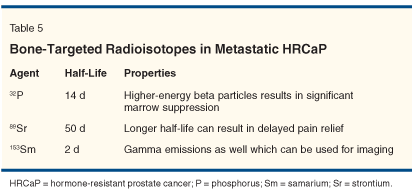
Three randomized trials have evaluated 89Sr as compared with placebo in painful, metastatic CaP, with mixed results.[39-42] The largest of these trials (126 patients) found improvements in the proportion of patients discontinuing analgesics at 3 months and freedom from new painful metastatic lesions, but no difference in survival or pain relief.[40] A trial comparing 89Sr to conventional radiation therapy (focal or hemibody) found no difference in median survival or pain relief, although patients in the 89Sr group were less likely to need focal radiation to a new site.[39]
One randomized trial has compared 153Sm to placebo in HRCaP and found that men randomized to 153Sm had a significant reduction in pain within 2 weeks of treatment, with reductions in opiate use.[43] Unfortunately, longer-term comparisons were not possible because crossover was allowed at 4 weeks.
Overall, while the results of the bone-targeting radioisotopes in HRCaP are not impressive, these treatments do play a role in pain palliation. There is little to no evidence that their effects last beyond 6 months or are associated with survival advantages. Appropriate patients for this therapy have HRCaP with multiple, painful osteoblastic metastases (such therapies are unlikely to provide relief in osteolytic metastases).
Investigational Approaches
There is a fair amount of excitement in the CaP community for several novel therapeutic approaches that are now in the clinic. These approaches include novel chemotherapeutics, mammalian target of rapamycin (mTOR) inhibition, inhibitors of histone deacetylase, immunomodulatory therapies, antiangiogenic therapies, endothelin-receptor antagonists, and inhibitors of heat shock protein 90. Below, we will focus on novel approaches that are showing promise in late-stage clinical trials.
• Immunotherapy-One such approach is immunotherapy for CaP. Several different strategies for improving the immune response to CaP have been evaluated clinically. The most advanced is the sipuleucel-T (APC8015, Provenge) vaccine. This vaccine consists of the patient's own dendritic cells (antigen-presenting cells), which are collected, exposed ex vivo to human prostatic acid phosphatase (PAP) and granulocyte-macrophage colony-stimulating factor (GM-CSF), then reintroduced.
In a placebo-controlled phase III trial in 127 men with asymptomatic, metastatic HRCaP, patients received sipuleucel-T or placebo every 2 weeks for three doses. Those in the placebo group received a frozen version of sipuleucel-T at progression.[44] Interestingly, while the time to progression in this relatively small trial was not different between the two arms (11.7 vs 10.0 weeks, for treatment vs control, respectively), there was a significant survival difference favoring the treatment arm (25.9 vs 21.4 months, P = .01). A confirmatory phase III trial is underway to attempt to validate this exciting result.
Other vaccine approaches have also shown promise, including the use of allogeneic whole prostate cancer cell lines (GVAX) and a PSA-targeting agent (Prostvac).[45]
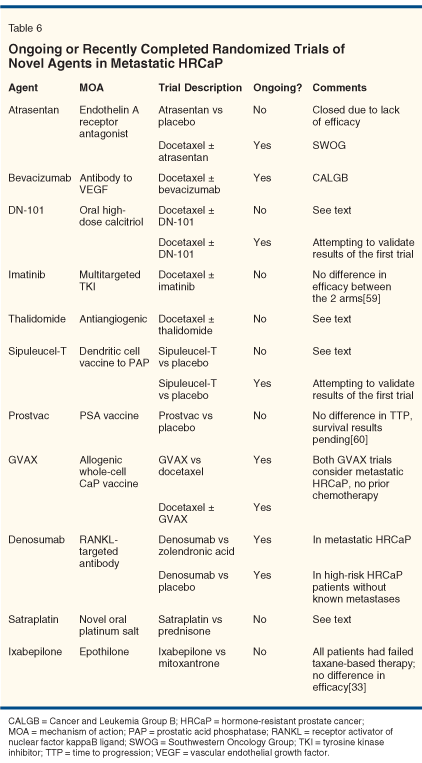
• Vitamin D-The use of vitamin D as a differentiation agent has also been explored in CaP. Given that high doses of 1,25 dihydroxyvitamin D induce hypercalcemia, analogs of calcitriol have been used. DN-101 is an oral formulation of calcitriol that was evaluated in a 250-patient trial of men with metastatic HRCaP who were randomized to DN-101 plus weekly docetaxel or placebo plus weekly docetaxel. At an interim analysis, the investigators found a trend toward improvement in PSA response rate and overall survival (23.5 vs 16.4 months, P = .07).[46] Interestingly, substantial reductions in serious adverse events and any grade 3 or 4 adverse event was seen in the DN-101 arm (27% vs 41% for serious adverse events and 58% vs 70% for any grade 3 or 4 event). These results are promising, but more follow-up and a confirmatory trial are needed (and ongoing).
• Antiangiogenic Therapy-Antiangiogenic therapy may also have a role in the treatment of metastatic HRCaP, at least in combination with chemotherapy. A phase II trial of bevacizumab (Avastin, an antibody to vascular endothelial growth factor [VEGF]) plus docetaxel and estramustine performed by CALGB demonstrated a PSA response rate of 65% for this combination.[47] A phase III trial of every-3-week docetaxel plus bevacizumab or placebo is ongoing.
Thalidomide (Thalomid), an oral drug with antiangiogenic properties, has been evaluated in a randomized phase II trial in combination with docetaxel.[48] A higher PSA response rate (53% vs 37%), progression-free survival (5.9 vs 3.7 months), and survival at 18 months (68% vs 43%) was seen in the combination arm vs the docetaxel-alone arm, but none of these differences was statistically significant. Phase II studies of sunitinib (Sutent) and sorafenib (Nexavar), both small-molecule inhibitors of the VEGF receptor as well as multiple other tyrosine kinases, are also ongoing.
• Novel Chemotherapeutic Agents-Finally, several novel chemotherapies are in late-stage clinical testing in HRCaP. These include the epothilone B analog ixabepilone, which stabilizes polymerized micotubules and seems to have activity in taxane-refractory models, and the orally bioavailable third-generation platinum analog satraplatin.[49,50] Of note, an international randomized phase III trial of satraplatin as a second-line chemotherapeutic agent in metastatic HRCaP has been reported to demonstrate a statistically significant improvement in progression-free survival as compared with prednisone.[51] To date, this report is in press-release form only.
Conclusions
HRCaP is a heterogeneous disease state, but often a deadly one. While only docetaxel-based chemotherapy is proven to improve survival in this setting, a wide range of therapies may be effective for any individual. These therapies include secondary hormonal manipulations, chemotherapy, watchful waiting, and clinical trials. Proper patient selection is important, relying on factors such as PSA velocity, comorbidities, Gleason sum, performance status, and the presence of symptomatic metastatic disease. Palliative maneuvers, such as external-beam radiation, bisphosphonates, radiopharmaceuticals, and pain management are critical for appropriate patient management. Several promising novel therapies are in late-stage testing and will hopefully provide further treatment options for these patients.
Disclosures:
Dr. Kantoff is a consultant for Abbott, Pfizer, Sanofi-Aventis, AstraZeneca, Bristol-Myers Squibb, TAP, and Amgen. Dr. Ross has received research grants from Genetech, Sanofi-Aventis, and Novartis.
References:
1. Pound CR, Partin AW, Eisenberger MA, et al: Natural history of progression after PSA elevation following radical prostatectomy. JAMA 281:1591-1597, 1999.
2. Scher HI, Heller G: Clinical states in prostate cancer: Toward a dynamic model of disease progression. Urology 55:323-327, 2000.
3. Bubley GJ, Carducci M, Dahut W, et al: Eligibility and response guidelines for phase II clinical trials in androgen-independent prostate cancer: Recommendations from the Prostate-Specific Antigen Working Group. J Clin Oncol 17:3461-3467, 1999.
4. Oefelein MG, Cornum R: Failure to achieve castrate levels of testosterone during luteinizing hormone releasing hormone agonist therapy: The case for monitoring serum testosterone and a treatment decision algorithm. J Urol 164:726-729, 2000.
5. Manni A, Bartholomew M, Caplan R, et al: Androgen priming and chemotherapy in advanced prostate cancer: Evaluation of determinants of clinical outcome. J Clin Oncol 6:1456-1466, 1988.
6. Feldman BJ, Feldman D: The development of androgen-independent prostate cancer. Nat Rev Cancer 1:34-45, 2001.
7. Shah RB, Mehra R, Chinnaiyan AM, et al: Androgen-independent prostate cancer is a heterogeneous group of diseases: Lessons from a rapid autopsy program. Cancer Res 64:9209-9216, 2004.
8. Smith MR, Kabbinavar F, Saad F, et al: Natural history of rising serum prostate-specific antigen in men with castrate nonmetastatic prostate cancer. J Clin Oncol 23:2918-2925, 2005.
9. Tannock IF, de Wit R, Berry WR, et al: Docetaxel plus prednisone or mitoxantrone plus prednisone for advanced prostate cancer. N Engl J Med 351:1502-1512, 2004.
10. Petrylak DP, Tangen CM, Hussain MH, et al: Docetaxel and estramustine compared with mitoxantrone and prednisone for advanced refractory prostate cancer. N Engl J Med 351:1513-1520, 2004.
11. Halabi S, Small EJ, Kantoff PW, et al: Prognostic model for predicting survival in men with hormone-refractory metastatic prostate cancer. J Clin Oncol 21:1232-1237, 2003.
12. Nejat RJ, Rashid HH, Bagiella E, et al: A prospective analysis of time to normalization of serum testosterone after withdrawal of androgen deprivation therapy. J Urol 164:1891-1894, 2000.
13. Lam JS, Leppert JT, Vemulapalli SN, et al: Secondary hormonal therapy for advanced prostate cancer. J Urol 175:27-34, 2006.
14. Scher HI, Kelly WM, Zhang ZF, et al: Post-therapy serum prostate-specific antigen level and survival in patients with androgen-independent prostate cancer. J Natl Cancer Inst 91:244-251, 1999.
15. Labrie F, Dupont A, Giguere M, et al: Benefits of combination therapy with flutamide in patients relapsing after castration. Br J Urol 61:341-346, 1988.
16. Fowler JE Jr, Pandey P, Seaver LE, et al: Prostate specific antigen after gonadal androgen withdrawal and deferred flutamide treatment. J Urol 154:448-453, 1995.
17. Fossa SD, Slee PH, Brausi M, et al: Flutamide versus prednisone in patients with prostate cancer symptomatically progressing after androgen-ablative therapy: A phase III study of the European organization for research and treatment of cancer genitourinary group. J Clin Oncol 19:62-71, 2001.
18. Joyce R, Fenton MA, Rode P, et al: High dose bicalutamide for androgen independent prostate cancer: Effect of prior hormonal therapy. J Urol 159:149-153, 1998.
19. Kassouf W, Tanguay S, Aprikian AG: Nilutamide as second line hormone therapy for prostate cancer after androgen ablation fails. J Urol 169:1742-1744, 2003.
20. Nakabayashi M, Regan MM, Lifsey D, et al: Efficacy of nilutamide as secondary hormonal therapy in androgen-independent prostate cancer. BJU Int 96:783-786, 2005.
21. Kelly WK, Scher HI: Prostate specific antigen decline after antiandrogen withdrawal: The flutamide withdrawal syndrome. J Urol 149:607-609, 1993.
22. Small EJ, Halabi S, Dawson NA, et al: Antiandrogen withdrawal alone or in combination with ketoconazole in androgen-independent prostate cancer patients: A phase III trial (CALGB 9583). J Clin Oncol 22:1025-1033, 2004.
23. Taplin ME, Rajeshkumar B, Halabi S, et al: Androgen receptor mutations in androgen-independent prostate cancer: Cancer and Leukemia Group B Study 9663. J Clin Oncol 21:2673-2678, 2003.
24. Manikandan R, Srirangam SJ, Pearson E, et al: Diethylstilboestrol versus bicalutamide in hormone refractory prostate carcinoma: A prospective randomized trial. Urol Int 75:217-221, 2005.
25. Bland LB, Garzotto M, DeLoughery TG, et al: Phase II study of transdermal estradiol in androgen-independent prostate carcinoma. Cancer 103:717-723, 2005.
26. Dawson NA, Conaway M, Halabi S, et al: A randomized study comparing standard versus moderately high dose megestrol acetate for patients with advanced prostate carcinoma: Cancer and Leukemia Group B study 9181. Cancer 88:825-834, 2000.
27. O'Donnell A, Judson I, Dowsett M, et al: Hormonal impact of the 17alpha-hydroxylase/C(17,20)-lyase inhibitor abiraterone acetate (CB7630) in patients with prostate cancer. Br J Cancer 90:2317-2325, 2004.
28. Kruit WH, Stoter G, Klijn JG: Effect of combination therapy with aminoglutethimide and hydrocortisone on prostate-specific antigen response in metastatic prostate cancer refractory to standard endocrine therapy. Anticancer Drugs 15:843-847, 2004.
29. Cougar Biotechnology initiates phase II trial of CB7630 (abiraterone acetate). Available at www.cougarbiotechnology.com. Accessed January 7, 2007.
30. Tannock IF, Osoba D, Stockler MR, et al: Chemotherapy with mitoxantrone plus prednisone or prednisone alone for symptomatic hormone-resistant prostate cancer: A Canadian randomized trial with palliative end points. J Clin Oncol 14:1756-1764, 1996.
31. Kantoff PW, Halabi S, Conaway M, et al: Hydrocortisone with or without mitoxantrone in men with hormone-refractory prostate cancer: Results of the Cancer and Leukemia Group B 9182 study. J Clin Oncol 17:2506-2513, 1999.
32. Storlie JA, Buckner JC, Wiseman GA, et al: Prostate specific antigen levels and clinical response to low dose dexamethasone for hormone-refractory metastatic prostate carcinoma. Cancer 76:96-100, 1995.
33. Lin AM, Rosenberg JE, Weinberg VK, et al: Clinical outcome of taxane-resistant hormone refractory prostate cancer patients treated with subsequent chemotherapy (ixabepilone or mitoxantrone/prednisone) (abstract 4558). J Clin Oncol 24(18S):231s, 2006.
34. Oh WK, Manola J, Babcic V, et al: Response to second-line chemotherapy in patients with hormone refractory prostate cancer receiving two sequences of mitoxantrone and taxanes. Urology 67:1235-1240, 2006.
35. Saad F, Gleason DM, Murray R, et al: A randomized, placebo-controlled trial of zoledronic acid in patients with hormone-refractory metastatic prostate carcinoma. J Natl Cancer Inst 94:1458-1468, 2002.
36. Dearnaley DP, Sydes MR, Mason MD, et al: A double-blind, placebo-controlled, randomized trial of oral sodium clodronate for metastatic prostate cancer (MRC PR05 Trial). J Natl Cancer Inst 95:1300-1311, 2003.
37. Small EJ, Smith MR, Seaman JJ, et al: Combined analysis of two multicenter, randomized, placebo-controlled studies of pamidronate disodium for the palliation of bone pain in men with metastatic prostate cancer. J Clin Oncol 21:4277-4284, 2003.
38. McClung MR, Lewiecki EM, Cohen SB, et al: Denosumab in postmenopausal women with low bone mineral density. N Engl J Med 354:821-831, 2006.
39. Quilty PM, Kirk D, Bolger JJ, et al: A comparison of the palliative effects of strontium-89 and external beam radiotherapy in metastatic prostate cancer. Radiother Oncol 31:33-40, 1994.
40. Porter AT, McEwan AJ, Powe JE, et al: Results of a randomized phase-III trial to evaluate the efficacy of strontium-89 adjuvant to local field external beam irradiation in the management of endocrine resistant metastatic prostate cancer. Int J Radiat Oncol Biol Phys 25:805-813, 1993.
41. Lewington VJ, McEwan AJ, Ackery DM, et al: A prospective, randomised double-blind crossover study to examine the efficacy of strontium-89 in pain palliation in patients with advanced prostate cancer metastatic to bone. Eur J Cancer 27:954-958, 1991.
42. Buchali K, Correns HJ, Schuerer M, et al: Results of a double blind study of 89-strontium therapy of skeletal metastases of prostatic carcinoma. Eur J Nucl Med 14:349-351, 1988.
43. Sartor O, Reid RH, Hoskin PJ, et al: Samarium-153-lexidronam complex for treatment of painful bone metastases in hormone-refractory prostate cancer. Urology 63:940-945, 2004.
44. Small EJ, Schellhammer PF, Higano CS, et al: Placebo-controlled phase III trial of immunologic therapy with sipuleucel-T (APC8015) in patients with metastatic, asymptomatic hormone refractory prostate cancer. J Clin Oncol 24:3089-3094, 2006.
45. Kaufman HL, Wang W, Manola J, et al: Phase II randomized study of vaccine treatment of advanced prostate cancer (E7897): A trial of the Eastern Cooperative Oncology Group. J Clin Oncol 22:2122-2132, 2004.
46. Beer TM, Ryan CW, Venner P, et al: Interim results from ASCENT: A double blind randomized study of DN-101 plus docetaxel vs placebo plus docetaxel in androgen-independent prostate cancer (abstract 4516). J Clin Oncol 23(16S):382s, 2005.
47. Picus J, Halabi S, Rini BI, et al: The use of bevacizumab with docetaxel and estramustine in hromone refractory prostate cancer: initial results of CALGB 90006 (abstract 1578). Proc Am Soc Clin Oncol 22:393, 2003.
48. Dahut WL, Gulley JL, Arlen PM, et al: Randomized phase II trial of docetaxel plus thalidomide in androgen-independent prostate cancer. J Clin Oncol 22:2532-2539, 2004.
49. Hussain M, Tangen CM, Lara PN, Jr., et al: Ixabepilone (epothilone B analogue BMS-247550) is active in chemotherapy-naive patients with hormone-refractory prostate cancer: A Southwest Oncology Group trial S0111. J Clin Oncol 23:8724-8729, 2005.
50. Sternberg CN, Whelan P, Hetherington J, et al: Phase III trial of satraplatin, an oral platinum plus prednisone vs prednisone alone in patients with hormone-refractory prostate cancer. Oncology 68:2-9, 2005.
51. Satraplatin: A third generation oral platinum drug. Available at www. spectrumpharm.com/satraplatin.html. Accessed January 7, 2007.
52. Oh WK, Kantoff PW, Weinberg V, et al: Prospective, multicenter, randomized phase II trial of the herbal supplement, PC-SPES, and diethylstilbestrol in patients with androgen-independent prostate cancer. J Clin Oncol 22:3705-3712, 2004.
53. Pomerantz M, Manola J, Taplin ME, et al: Phase II study of low dose and high dose premarin in androgen independent prostate cancer (abstract 4560). J Clin Oncol 24(18S):231s, 2006.
54. Abratt RP, Brune D, Dimopoulos MA, et al: Randomised phase III study of intravenous vinorelbine plus hormone therapy versus hormone therapy alone in hormone-refractory prostate cancer. Ann Oncol 15:1613-1621, 2004.
55. Di Lorenzo G, Pizza C, Autorino R, et al: Weekly docetaxel and vinorelbine (VIN-DOX) as first line treatment in patients with hormone refractory prostate cancer. Eur Urol 46:712-716, 2004.
56. Kelly WK, Curley T, Slovin S, et al: Paclitaxel, estramustine phosphate, and carboplatin in patients with advanced prostate cancer. J Clin Oncol 19:44-53, 2001.
57. Oh WK, Halabi S, Kelly WK, et al: A phase II study of estramustine, docetaxel, and carboplatin with granulocyte-colony-stimulating factor support in patients with hormone-refractory prostate carcinoma: Cancer and Leukemia Group B 99813. Cancer 98:2592-2598, 2003.
58. Hudes G, Einhorn L, Ross E, et al: Vinblastine versus vinblastine plus oral estramustine phosphate for patients with hormone-refractory prostate cancer: A Hoosier Oncology Group and Fox Chase Network phase III trial. J Clin Oncol 17:3160-3166, 1999.
59. Matthew P, Thall PF, Johnson MM, et al: Preliinary results of a randomized placebo-controlled double-blind trial of weekly docetaxel combined with imatinib in men with metastatic androgen-independent prostate cancer and bone metastases (abstract 4562). J Clin Oncol 24(18S):232s, 2006.
60. Kantoff P, Glode LM, Tannenbaum SI, et al: Randomized, double-blind, vector-controlled study of targeted immunotherapy in patients with hormone-refractory prostate cancer (abstract 2501). J Clin Oncol 24(18S):100s, 2006.